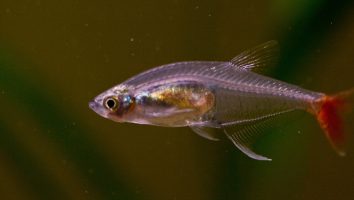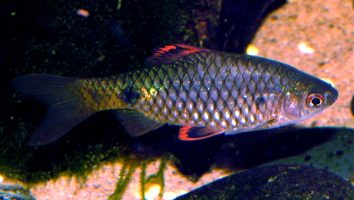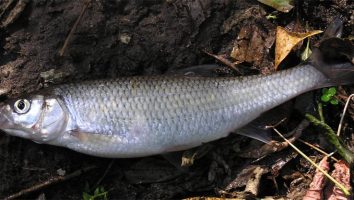The Penguin Tetra (Thayeria boehlkei) is a freshwater fish that originates from the rivers of South America.
This guide will teach you everything you need to know about Penguin Tetra care. You’ll learn about their diet, size, lifespan, and more!
Table of contents
Species overview
Penguin Tetras (Thayeria boehlkei) are found throughout the Amazon Basin in Peru, Brazil, and Bolivia.
They prefer blackwater rivers and streams which are slow-moving and have a lot of fallen leaves and other vegetation. This type of environment is actually pretty common in the Amazon Basin which is why you’ll find these fish in a lot of different areas.
Penguin Tetras are omnivores and in the wild, they eat a diet of small insects, crustaceans, and plants.
Penguin Tetras are a popular choice for freshwater aquariums because of their unique black and white coloration. They are also a relatively small fish which makes them a good choice for nano tanks.
Appearance

The first thing you’ll notice about this freshwater fish is their black body. This coloration is solid all over their bodies with a few fins being a bit lighter in color.
The fins on the Penguin Tetra are all translucent with the exception of their dorsal fin. The dorsal fin is black and starts about two-thirds of the way back on their bodies.
This species has a very tall and thin body shape that makes them look a bit like a torpedo. They have a forked caudal fin that’s symmetrical on the top and bottom.
The fins on the Penguin Tetra are all relatively small with the exception of their pectoral fins. These fins are large and help them maneuver through the water with ease.
Penguin Tetras have large eyes that really stand out on their faces. Their mouths are small and tend to be downturned.
Lifespan
The Penguin Tetra has a lifespan of up to 5 years in captivity, although the average is closer to 3 years.
As with all fish, there are a number of factors that can impact their lifespan. Things like water quality, diet, and stress levels can all play a role.
That being said, these are generally very hardy fish and as long as you take good care of them they should be around for a while.
Size
Penguin tetras only grow to be about 1.5 inches in length.
Tank
Tank Size
The minimum recommended tank size for penguin tetras is 20 gallons. If you plan on keeping a school of these fish, you should consider a tank that is at least 30 gallons.
Penguin tetras are a schooling fish, so they do best when they are kept in groups of 6 or more. A 20 gallon tank will allow you to keep a school of these fish, but a larger tank will give them more room to swim and explore.
Water Parameters
The Penguin Tetra is a schooling fish, so you will want to keep them in groups of 5 or more. They do best in a planted aquarium with plenty of hiding spots.
They are a peaceful fish that can be kept with other peaceful community fish.
The Penguin Tetra is a tropical fish, so they will need a heater to maintain a water temperature between 72-82 degrees Fahrenheit.
The pH level should be between 6.0-8.0 and the water hardness should be between 2-12 dGH.
The Penguin Tetra is not a picky eater and will accept most aquarium foods.
- Water temperature: 72-82 degrees Fahrenheit
- pH levels: 6.0-8.0
- Water hardness: 2-12 dGH
- Alkalinity Levels: Not required
What To Put In Their Tank
Penguin Tetras are a peaceful freshwater fish that make a great addition to any community aquarium. They’re not too picky when it comes to their tank mates, but we recommend avoiding any aggressive species.
When it comes to setting up the inside of their habitat, you have a few different options.
A classic gravel substrate is always a good choice. You could also go with something softer like sand (just be aware that this can cloud the water a bit).
These fish like to have some plants to hide in, but they’re not too picky about what kind you use. Hornwort, Water Wisteria, and Java Moss are all great choices.
You can also add some rocks and driftwood to their tank. Just be sure that any pieces you use are securely anchored since these fish like to nibble on things.
One thing we don’t recommend is using a lot of bright colors in their tank. Penguin Tetras are a little shy and too much stimulation can cause them stress.
Common Diseases
Penguin tetras are one of the hardiest freshwater fish out there. They’re not very prone to sickness and can withstand a wide range of water conditions.
However, that doesn’t mean that they can’t get sick. Any fish can get sick if the conditions in their tank are poor enough.
The most common disease that penguin tetras experience is ich. This is a pretty well-known disease in the fish-keeping world and it’s pretty easy to spot.
Ich will present itself as white spots on the body, fish, and gills of your fish. If you see this, it’s important to act fast and begin treatment immediately.
The good news is that ich is pretty easy to treat. There are a lot of different methods out there, so you’ll definitely be able to find one that works for you.
The best way to prevent your penguin tetras from getting sick is to simply maintain the quality of the water in their tank. A tank with clean and stable water conditions is the best way to keep your fish healthy and disease-free.
Behavior & Temperament
Penguin tetras are relatively peaceful fish that do best in schools. In the wild, they live in slow-moving rivers and streams in South America.
Penguin tetras are schooling fish, which means they feel more comfortable and secure when they’re around other fish. We recommend keeping at least six together, but more is always better.
These fish are shy, so putting them in a tank with other peaceful fish will help them feel more at ease. They’re also mid-dwellers, so they’ll spend most of their time in the middle of the tank rather than the top or bottom.
Penguin tetras are known for being good jumpers, so it’s important to have a tight-fitting lid on your tank. They’re also known to nibble on live plants, so it’s best to stick to fake plants if you decide to put any in your Penguin tetra tank.
Tank Mates
The best tank mates for Penguin tetras are other small, peaceful fish. These fish are not only small but also shy.
They prefer to stay in groups and won’t do well if they’re the only fish in the tank.
Penguin tetras are also sensitive to water conditions. As a result, they need to be in a well-maintained tank.
To help get you started, here are some compatible tank mates that tend to work well:
- Neon Tetra
- Harlequin Rasbora
- Cardinal Tetra
- Ember Tetra
- Ghost Shrimp
- Guppies
- Mollies
- Platies
Breeding
Penguin tetras are pretty easy to breed in captivity. They don’t have too many specific requirements and will often spawn without any intervention from the breeder.
To start, you’ll need a breeding tank. It should hold at least 20 gallons of water. Then, add some hiding places. Breeding penguin tetras in groups can be tricky since they’re known to be a bit nippy. So, it’s important to give them plenty of places to hide.
Penguin tetras are also known to be jumpers. So, make sure that the tank is covered.
When ready, add six penguin tetras to the tank. It’s best to have two females for every male. Once they’re in the breeding tank, feed them live foods. Bloodworms and brine shrimp are good choices.
Spawning usually happens at night. The female will lay her eggs on plants or other surfaces in the tank. The male will then fertilize them.
Once the eggs are fertilized, the parents will usually eat them. So, it’s important to remove the adults as soon as possible.
The eggs will hatch in about 24 hours. When they do, you can start feeding the fry live foods. Bloodworms and brine shrimp are good choices. You can also give them crushed flake food.
Make sure to feed the fry several times a day. They need to eat often to survive.
Conclusion
Penguin Tetras are a great fish for beginner aquarists. They’re relatively easy to care for and are very peaceful, making them a great addition to community tanks.
They’re also very active fish, which can be a lot of fun to watch. Overall, we think they’re a great option for anyone looking for a low-maintenance fish that still has a lot of personality.












